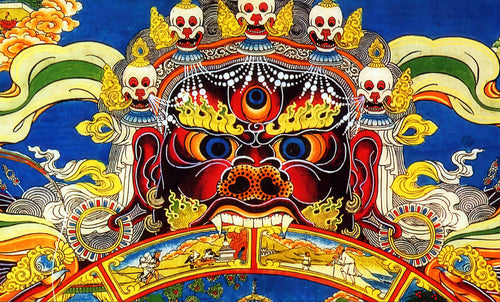
Jewish Kabbalah and the Epicurus Paradox - part 4
Fabrizio PiolaAnd here we are, after a fair amount of running through the centuries and cultures, finally in media re.
Like the religions and philosophies we have examined so far, Kabbalah is also a cultural tradition but at the same time it is also a religious tradition. It does not have a single voice, but is a polyphony of authors who perform distinct parts while respecting an underlying harmony. It is not made up of a single book, not even if this book is the Zohar, but is a library of unique and yet interconnected texts that present different cultural influences, sometimes opposed, sometimes even remote and completely unexpected. By conducting an investigation now into what the position of Kabbalah is on the problem of evil, we will come across exactly this degree of complexity, relative to the succession and articulation and opposition of the voices, and of the sources. Not being a cultural snob nor a revisionist by principle, I have chosen to rely, with the rational filter turned on and the automatic updating of data and discoveries, on what Professor Gershom Scholem zl had once illustrated in his masterly works, whose corpus of hermeneutics and explanations has recently been revisited and expanded in an illuminating and very personal way by his successor, Professor Moshe Idel of the Hebrew University of Jerusalem.
For an effective synthesis of the problem throughout the centuries, we refer to Gershom Scholem – La Cabala – Edizioni Mediterranee , reprint 1982, pages 128-132 , while for the latter I would certainly recommend Moshe Idel - Qabbalah, Nuove Prospettive – 1988, expanded and revised edition of 2010 – Gli Adelphi n° 366.
*** **** ***
One of the first positions on the problem of Evil manifested within Kabbalah was that expressed by the unknown author of a treatise which presents a not insignificant neo-Platonic imprint, the מַעֲרֶכֶת הָאֱלֹהוּת Ma'arekhet ha Elohut , (The Order of Divinity) according to whose author (for RAMAK Todros Abulafia, for others Bahya ben Ashe:
The text, written around the 13th century, was printed for the first time in Ferrara only in 1557, as a work by Perez the Tosafist. We cannot say with certainty whether these neo-Platonic influences were already present in the original work or whether they entered the text through the work of the editor of Hebrew language and culture who prepared it for printing. In fact, positions in which on one side are placed the spirit and the good and on the other matter and evil and these things in their relationship take on positive or negative ethical colors are substantially foreign to the core of the Kabbalistic doctrines that the authors protagonists of the Provençal and Catalan "renaissance" of the 10th century had inherited from the ancient Masters.
In fact, the approach that we can examine in the great primary text of archaic Kabbalah, the Sepher haBahir (“Book of Brilliance”) , is quite different. According to the edition commented by my teacher Rabbi Aryeh Kaplan , the attention of the righteous man had to be concentrated on observing the dynamics of the functioning of the “fearsome” sephirah Geburah, also called Din, or “the Left Hand of the Most Holy One – Blessed be He” , due to its tendency, if not sufficiently counterbalanced by acts of pure “Ḥesed”, to evolve into the active presence of Evil.
An extraordinary overabundance of Geburah, which must have occurred in the history of the World on at least one occasion, would have given rise to a flaw in the homeostatic system of the sephirotic holon to finally assume an autonomous and sufficient form to configure itself as a “part”, potentially also capable of freeing itself from the self-regulating mechanisms present in the sub-tree of Gevurah itself. Once relatively freed from the central nucleus of Gevurah, becoming an extremist pole and indulging in its nature which has become malignant even though starting from positions which intrinsically are not so – just as severity can become cruelty, rebuke sarcasm and humiliation and correction can become sadism and torture – it gave rise to the appearance of “a quality whose name is Evil”. According to Isaac the Blind (or rather “The Dazzled”) of Nimes and his school – Scholem explains – this overabundance of negativity and coercion had been
And this would be, according to Scholem, in summary the doctrinal conclusion reached by the Catalan-Provençal Kabbalah tradition which, according to historians, would have given us as its ultimate fruit the written and fixed redaction of the Zohar for posterity.
This majority Kabbalistic tradition was largely contrasted by a minority current that Scholem attributed in his work to those he defined as “Gnostic Kabbalists of Castile” .
According to them in fact:
It is therefore in the context of Gerona that the Kabbalists gathered around the Master Rabbi Azriel elaborate, within the doctrinal framework expressed by the Zohar, concepts relating to the problem of Evil such as Qliphot (=barks), Ha-Ilan Ha-Hizon (=the external tree”, which would be the entire apparatus created with the separatist drift of some aspects of Gevurah). We are in the XII-XIII century. From then on we will have to note the presence here and there resurfacing of Gnostic themes in the subsequent Kabbalah that were foreign to Kabbalah understood as Tradition and therefore in the great primary texts produced up to that time: Sefer Yetzirah, Sefer haBahir and Sefer ha Zohar, with respect to which a reading in a Gnostic key is a serious hermeneutic error or a rather serious voluntary distortion.
In times shortly after those of the Castilians, a different and very suggestive minority doctrine appeared, which can be described as the doctrine that links the rise of Evil with the dialectic between the Two Great Trees of Eden as described in Genesis, focusing our attention on what they called the "Mystery of the Tree of Knowledge", considered separately from the "Tree of Life":

For Scholem, both of the conceptions mentioned here last appear in Kabbalistic literature, without a clear distinction being made between them. Cosmic Evil deriving from the internal dialectic of the emanation process is not differentiated from Moral Evil produced by human actions. The Zohar demonstrates awareness of this separation and attempts on its own to mediate between these levels, distinguishing them but at the same time connecting them, postulating that the disposition to moral corruption, to evil in the form of temptation directed at the human person, derives from Cosmic Evil which is the realm of the Sitra Achra (סטרא אחרא).
The texts of the authors of Gerona were in fact much more colourful than those of the authors who insisted on the separation at the level of the trees of Eden, and tended to the personification of the various aspects of evil by giving them names taken from the tradition of ancestral Jewish folklore. > Q'liphot (קליפות) .
Instead, the Zohar, a very “high” literary text, preferred to suggest other mental images to the reader:
In other passages of the Zohar, the realm of evil is outlined almost in biological and organic terms as
The identification of evil with physical matter, although it occurs at times in the Zohar and other Kabbalistic books, never became an accepted doctrine.
At this point Scholem tells us something absolutely fundamental, which traces an objectively recognizable watershed between the Jewish Kabbalah and those which will later be defined as being of Gnostic, Hermetic or Christian origin:
But if the root of evil is naturally and genetically linked to the Tree of Life, of which it is only, so to speak, a “shoot”, then we understand why the Zohar repeatedly maintains and warns that a spark of Light and Holiness also exists in the Kingdom of the Sitra Achra , as a result of an emanation coming from the last sephirah, Malchut .
And just as the observance of a Mitzvot strengthens the Sitra HaKadusha (the Side of Holiness) , so every human transgression restores fire and life to the Sitra Ahra.
The two aspects are mysteriously linked and intertwined as were the two trees of Eden and it is up to Man to carry out the RECTIFICATION of this mixture and separate, in the name and on behalf of the Divine, the pure from the impure in his Kingdom of Malkhut.
In this way, Scholem tells us, the Zohar ends up granting Evil the nature of an entity, or a category of being, endowed with its own real metaphysical existence. And this creates problems of compatibility with the rest of the most ancient Kabbalah Tradition.
But against the position of the Zohar , stands the alternative vision of a great Master of the revival of the Qabbalah, a Spaniard contemporary of Abraham Aboulafia and one of my favorite Masters: Avraham Gikatilla . According to Scholem, these:
As the centuries passed and the path of human history entered into what we call the Modern Age, one of the few original developments of the Problem of Evil occurred at the time of the false Messiah Shabatai Zevi when, according to Scholem, it was Rabbi Nathan of Gaza , one of Zevi's main doctrinal references, who postulated in this regard that…
What can I say? It is a fascinating vision that gives much to think about. Above all, it invites us all, in my opinion, to ask ourselves very pertinent questions that contain within themselves great evolutionary potential for our knowledge and rectification.
Already in the days of the Gerona school, the great Hispanic Jewish kabbalist Nachmanides (Moses Ben Naḥman 1194–1270) was a fervent supporter of what he called the “return of all things to their essence” .
Thus, according to Nachmanides, Evil would also have returned in the end to the natural channel of Gevurah and the Sephirotic network. This great and glorious return, which according to Scholem had been somehow influenced by the Christian eschatology of apokatastasis (= reintegration), was according to Nachmanides one of the aspects of the Great Jubilee , an expression in turn of the controversial doctrine of the Shemittòt or Great Cycles , according to which – in particular and with regard to our theme – the reality of the presence of Evil in the different Shemittot was accepted, and in each Shemittàh it manifested itself according to the specific nature of the latter, be it a sephirotic, or zodiacal, or other aeon.
To conclude today's part we resort one last time to the words of Gershom Scholem, who refers to Kabbalistic traditions related to the triad of techniques Gematria, Notarikon and Temurah:
In the next part – בס''ד Besiyata Dishmaya, meaning with the help and consent of Gd – we will delve into the topic of Evil, Grace, Joy in Sorrow, and Sorrow in Joy in the extraordinary world of Chassidic Kabbalah. Shalom le kullam.
Fabrizio Piola
















































